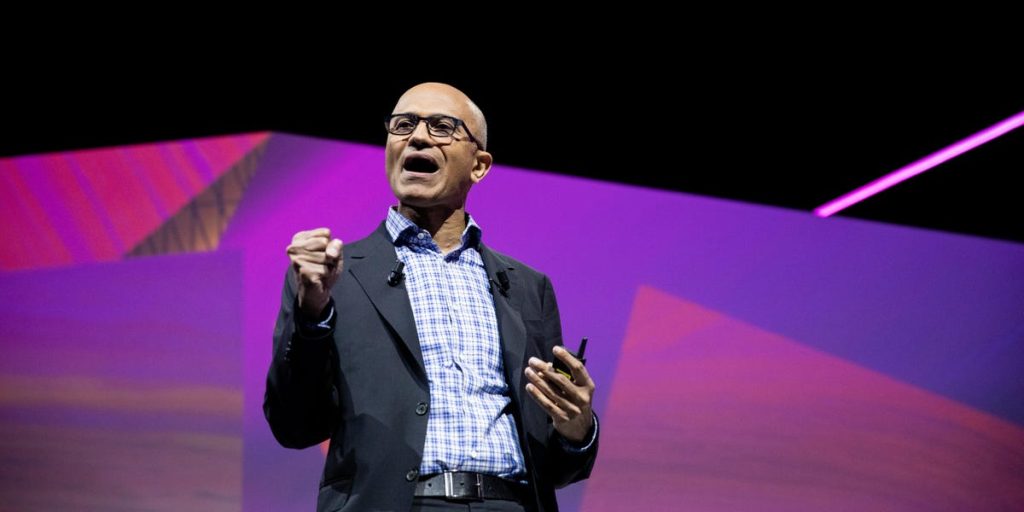- Microsoft was once a company that was rapidly fading from relevancy.
- That’s changed this year as the company has completed an epic turnaround.
- Its big bet on AI appears to be paying off while blockbuster deals are getting greenlit.
A decade ago, Microsoft was a company on its knees.
Steve Ballmer, anointed Bill Gates’ successor in 2000, was heading out the door following a failed tenure as CEO, which saw Microsoft fall down to Earth, while rivals like Apple and Google came to defy gravity.
For a tech firm that once reigned as the world’s most valuable company, the period was one of embarrassment — and not just because of the bizarre antics it was forced to put up with from its departing leader.
Microsoft had become a company whose attraction depended heavily on its storied past; its appeal in the future seemed to be rapidly fading.
It’s a history that is firmly behind the company: 2023 looks set to be the year Microsoft completes its glow-up.
Satya Nadella has played his cards carefully
Since replacing Ballmer in 2014, Microsoft CEO Satya Nadella has carefully helped the company rebuild itself to deliver a series of knockout blows to the competition this year.
For one, Microsoft is arguably the most influential power broker in AI.
In January, it emerged that Microsoft was placing a huge multibillion-dollar bet on ChatGPT developer OpenAI, giving it a stake in the company that has stoked fresh euphoria about AI in 2023.
That bet seems to be paying off on several fronts.
OpenAI has become something of a cash cow, with the Silicon Valley company generating revenue at a rate of around $1.3 billion per year, its CEO Sam Altman told staff, as reported by The Information.
For context, OpenAI’s revenue was just $28 million last year, making the introduction of a subscription tier for its Microsoft-cloud driven chatbot a decisively lucrative move.
The shift in focus to AI has helped Microsoft revamp its own suite of products, too.
Last month, the company introduced Copilot, a new vision of its tools that it describes as “an everyday AI companion” that stays with a Microsoft user across multiple devices. Nadella describes it as a “single unified experience centered around you.”
The company has proven to be deft at dealmaking, too.
On Friday, it received approval from the UK’s antitrust regulator to complete the $69 billion acquisition of video game company Activision Blizzard, giving it a clear path to complete the biggest deal in its history.
Though Microsoft was given a difficult path toward the completion of the deal, being forced to offer concessions that lessened the deal, it was able to restructure the deal in a way that kept all parties happy.
The UK’s Competition and Markets Authority described the resubmitted deal as a “gamechanger,” while Microsoft has oversight of franchises such as “Call of Duty,” which generate billions of dollars in sales.
Though Microsoft’s market capitalization sits at almost $2.5 trillion, it does, of course, face challenges.
It was recently reported by Sky News and others that the IRS said Microsoft owed the US Treasury $28.9 billion in back taxes, plus penalties and interest.
In a blog addressing the issue, Microsoft said it had changed its corporate structure and practices since the years covered by the IRS audit. As such, it believes the case is no longer relevant to its present practices and plans to appeal against the findings.
Meanwhile, when it comes to AI-related challenges, Nadella said during his testimony in the US Justice Department’s antitrust case against Google that even AI wasn’t enough to help Microsoft’s search engine Bing compete meaningfully against Google Search.
It runs a risk, too, by putting everything into AI, as the hype train behind the technology has the potential to derail if users begin to treat tools like ChatGPT as something to tread cautiously around. This is particularly notable, given chatbots’ habits of generating inaccuracies and made-up information.
These are thorny challenges that are not to be underestimated. But by and large, 2023 has been a remarkable year for Microsoft.
Read the full article here





